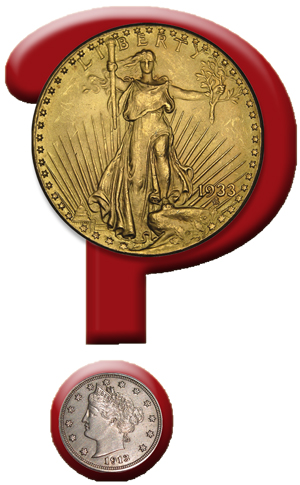 By Dr. Sol Taylor
By Dr. Sol Taylor
"Making Cents"
Saturday, December 13, 2008
| I |
n recent years, a few coins have appeared for sale or attribution which have raised some government eyebrows.
One such case was the attribution of one of the dozen or so "missing" 1974 aluminum cents that were sent to various members of Congress by Mary Brooks, then director of the U.S. Mint. The coin was submitted for attribution and grading and was then the subject of a tug-of-war between the feds and the owner(s), claiming the coin was never legally released for private ownership. That matter is still not resolved.
An August 15, 2006, press release from the Professional Numismatic Guild focused on the submission of the ten 1933 double eagles a few years ago, which has the ownership status up for court or government action. The coins reside at Fort Knox. They were displayed at the ANA convention in Denver a few years ago. The PNG warns dealers and collectors alike that certain rare coins such as the 1933 double eagle and even the 1913 Liberty head nickel might come under government scrutiny as "unauthorized" and thus subject to confiscation.
In February 2000, the PNG filed a 14-page "friend of the court" brief with the United States District Court for the Southern District on behalf of London coin dealer Stephen Fenton, whose 1933 double eagle was confiscated in 1986. Eventually a compromise was reached and the coin was sold at public auction for $7.59 million, with Fenton and the U.S. government sharing in the proceeds.
Unlike the Fenton case where the seizure was involuntary, the ten 1933 double eagles that were sent to the Mint for authentication and were arbitrarily confiscated; there was no due process, and as such, all such U.S. coins could be in jeopardy, according to PNG attorney Armen R. Vartian.
Dealer Abe Kosoff had sold more than one 1933 double eagle while in business in New York City in the 1950s. The feds ordered him to retrieve them — he managed to locate one — and turn it over to the feds — and then the coin was destroyed! Kosoff claimed he lost $9,000 in the matter.
The status of the 1913 Liberty head nickel was never challenged, but under similar cases, the feds could put this iconic coin under their scope and confiscate all five of them (with a current market value of more than $10 million).
The PNG warned that many coins, including all the pattern coins produced by the Mint and never officially put out for collectors could be seized. That could also apply to such modern varieties as the 1990 No-S proof cent, the plain-edge Presidential dollar coins, and possibly even Mint errors such as off-center and mis-struck coins.
For more details from the PNG, go online to PNGdealers.com.
One such case was the attribution of one of the dozen or so "missing" 1974 aluminum cents that were sent to various members of Congress by Mary Brooks, then director of the U.S. Mint. The coin was submitted for attribution and grading and was then the subject of a tug-of-war between the feds and the owner(s), claiming the coin was never legally released for private ownership. That matter is still not resolved.
An August 15, 2006, press release from the Professional Numismatic Guild focused on the submission of the ten 1933 double eagles a few years ago, which has the ownership status up for court or government action. The coins reside at Fort Knox. They were displayed at the ANA convention in Denver a few years ago. The PNG warns dealers and collectors alike that certain rare coins such as the 1933 double eagle and even the 1913 Liberty head nickel might come under government scrutiny as "unauthorized" and thus subject to confiscation.
In February 2000, the PNG filed a 14-page "friend of the court" brief with the United States District Court for the Southern District on behalf of London coin dealer Stephen Fenton, whose 1933 double eagle was confiscated in 1986. Eventually a compromise was reached and the coin was sold at public auction for $7.59 million, with Fenton and the U.S. government sharing in the proceeds.
Unlike the Fenton case where the seizure was involuntary, the ten 1933 double eagles that were sent to the Mint for authentication and were arbitrarily confiscated; there was no due process, and as such, all such U.S. coins could be in jeopardy, according to PNG attorney Armen R. Vartian.
Dealer Abe Kosoff had sold more than one 1933 double eagle while in business in New York City in the 1950s. The feds ordered him to retrieve them — he managed to locate one — and turn it over to the feds — and then the coin was destroyed! Kosoff claimed he lost $9,000 in the matter.
The status of the 1913 Liberty head nickel was never challenged, but under similar cases, the feds could put this iconic coin under their scope and confiscate all five of them (with a current market value of more than $10 million).
The PNG warned that many coins, including all the pattern coins produced by the Mint and never officially put out for collectors could be seized. That could also apply to such modern varieties as the 1990 No-S proof cent, the plain-edge Presidential dollar coins, and possibly even Mint errors such as off-center and mis-struck coins.
For more details from the PNG, go online to PNGdealers.com.
©2008 SCV COMMUNICATIONS GROUP & SOL TAYLOR · ALL RIGHTS RESERVED.

![[Most Recent Quotes from www.kitco.com]](http://www.kitconet.com/images/quotes_special.gif)
